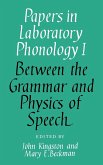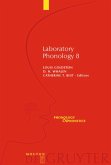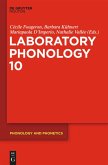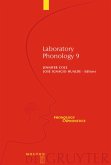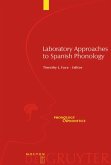The traditional focus of the Papers in Laboratory Phonology series has been on the relationship of phonology to phonetics. The present volume expands this domain in setting two new themes: language acquisition and lexical representation. Contributors tackle the central problem of what constitutes a possible word in generative phonology, employing contemporary approaches such as Optimality Theory, connectionism, and stochastic grammars. Several papers integrate the issues of lexical representation and language acquisition by undertaking to explain the organization of the adult phonological system as the end product of the acquisition process. Others explore the role of sequential frequency in the lexicon and the development of fine temporal control in production in the emergence of phonological segments and features. Papers in Laboratory Phonology V: Acquisition and the Lexicon will thus be of interest to a wide range of researchers in phonetics, phonology, psycholinguistics, cognitive science, and the study of speech and communication disorders.
Table of contents:
Part I. General Papers: 1. Coarticulation and physical models of the vocal tract Kevin Munhall, E. Vatikiotis-Bateson, and M. Kawato; 2. Production of Schwa by Japanese speakers of English: an acoustic study of shifts in coarticulatory strategies from L1 to L2 Yuko Kondo; 3. Manner and place conflicts in the articulation of accent in Australian English Jonathan Harrington, Janet Fletcher and Mary Beckman; 4. Phrasal influences on articulatory detail Dani Byrd, Shrikanth Narayanan, Abigail Kaun, and Elliot Saltzman; 5. 'Clocks' and 'glue': global timing and intergestural cohesion Elliot Saltzman, Anders Lofqvist, and Subhorbrath Mitra; 6. Commentary: where is coarticulation? John Coleman; 7. Morphemic invariance and the phonology-phonetics boundary Donca Steriade; 8. Investigating universals of sound change: the effect of vowel height and duration on the development of distinctive nasalization John Hajek and Shinji Maeda; 9. Effects of language experience on perceptual organization of vowel sounds Andrew Lotto, Keith Kluender, and Lori Holt; 10. Commentary: from second thoughts to first principles Bjorn Lindblom; 11. What is a starred tone? Evidence from Greek Amalia Arvaniti, D. Robert Ladd, and Ineke Mennen; 12. The boundary tones are coming: on the nonperipheral realization of boundary tones Carlos Gussenhoven; 13. Lexical versus 'phonological' representations of Mandarin Sandhi tones Shu-hui Peng; 14. Commentary: integrating the phonetics and phonology of tone alignment Jennifer Cole; Part II. Special Topics: 15. Developmental changes in speech perception and early word learning: is there a link? Janet Werker and Christine Stager; 16. Covert contrast as a stage in the acquisition of phonetics and phonology James Scobie, Fiona Gibbon and William Hardcastle; 17. Lexical frequency effects on young children's imitative productions Mary Beckman and Jan Edwards; 18. Developmental changes in infants' sensitivity to internal syllable structure Mara Goodman; Peter Jusczyk, and Angela Bauman; 19. Commentary Jan Edwards; 20. Lexicalization of sound change and alternating environments Joan Bybee; 21. Adults' sensitivity to phonotactic probabilities in English words Rebecca Treiman, Brett Kessler, Stephanie Knewasser, and Ruth Tincoff; 22. Temporally organized lexical representations as phonological units Stefan Frisch; 23. The influence of underspecification and Phoneme frequency in speech perception Rochelle Newman, James Sawusch, and Paul Luce; 24. Commentary: counting, connectionism, and lexical representation Gary Dell.
Papers in Laboratory Phonology V sets two new themes: language acquisition and lexical representation. Contributors tackle the central problems of what constitutes a possible phonological word and how the adult phonological system results from the acquisition process. The collection will be of interest to researchers in phonetics, phonology, and psycholinguistics.
This volume of the series integrates core areas of laboratory phonology with psycholinguistic themes.
Hinweis: Dieser Artikel kann nur an eine deutsche Lieferadresse ausgeliefert werden.
Table of contents:
Part I. General Papers: 1. Coarticulation and physical models of the vocal tract Kevin Munhall, E. Vatikiotis-Bateson, and M. Kawato; 2. Production of Schwa by Japanese speakers of English: an acoustic study of shifts in coarticulatory strategies from L1 to L2 Yuko Kondo; 3. Manner and place conflicts in the articulation of accent in Australian English Jonathan Harrington, Janet Fletcher and Mary Beckman; 4. Phrasal influences on articulatory detail Dani Byrd, Shrikanth Narayanan, Abigail Kaun, and Elliot Saltzman; 5. 'Clocks' and 'glue': global timing and intergestural cohesion Elliot Saltzman, Anders Lofqvist, and Subhorbrath Mitra; 6. Commentary: where is coarticulation? John Coleman; 7. Morphemic invariance and the phonology-phonetics boundary Donca Steriade; 8. Investigating universals of sound change: the effect of vowel height and duration on the development of distinctive nasalization John Hajek and Shinji Maeda; 9. Effects of language experience on perceptual organization of vowel sounds Andrew Lotto, Keith Kluender, and Lori Holt; 10. Commentary: from second thoughts to first principles Bjorn Lindblom; 11. What is a starred tone? Evidence from Greek Amalia Arvaniti, D. Robert Ladd, and Ineke Mennen; 12. The boundary tones are coming: on the nonperipheral realization of boundary tones Carlos Gussenhoven; 13. Lexical versus 'phonological' representations of Mandarin Sandhi tones Shu-hui Peng; 14. Commentary: integrating the phonetics and phonology of tone alignment Jennifer Cole; Part II. Special Topics: 15. Developmental changes in speech perception and early word learning: is there a link? Janet Werker and Christine Stager; 16. Covert contrast as a stage in the acquisition of phonetics and phonology James Scobie, Fiona Gibbon and William Hardcastle; 17. Lexical frequency effects on young children's imitative productions Mary Beckman and Jan Edwards; 18. Developmental changes in infants' sensitivity to internal syllable structure Mara Goodman; Peter Jusczyk, and Angela Bauman; 19. Commentary Jan Edwards; 20. Lexicalization of sound change and alternating environments Joan Bybee; 21. Adults' sensitivity to phonotactic probabilities in English words Rebecca Treiman, Brett Kessler, Stephanie Knewasser, and Ruth Tincoff; 22. Temporally organized lexical representations as phonological units Stefan Frisch; 23. The influence of underspecification and Phoneme frequency in speech perception Rochelle Newman, James Sawusch, and Paul Luce; 24. Commentary: counting, connectionism, and lexical representation Gary Dell.
Papers in Laboratory Phonology V sets two new themes: language acquisition and lexical representation. Contributors tackle the central problems of what constitutes a possible phonological word and how the adult phonological system results from the acquisition process. The collection will be of interest to researchers in phonetics, phonology, and psycholinguistics.
This volume of the series integrates core areas of laboratory phonology with psycholinguistic themes.
Hinweis: Dieser Artikel kann nur an eine deutsche Lieferadresse ausgeliefert werden.


